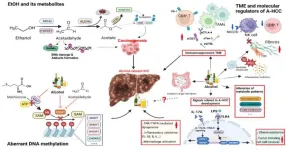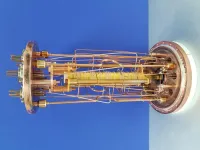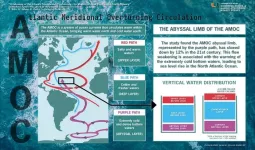(Press-News.org) Earth’s magnetic field cocoons our planet from the onslaught of cosmic radiation streaming through space while also shielding us from charged particles hurled outward by the sun. But the geomagnetic field is not stationary. Not only does magnetic north wobble, straying from true north (a geographically defined location), but occasionally, it flips. During these reversals, north becomes south, south becomes north, and in the process, the intensity of the magnetic field wanes.
But there’s also something called magnetic field excursions, brief periods in which the intensity of the magnetic field wanes and the dipole (or two magnetic poles) that we’re familiar with can disappear, replaced with multiple magnetic poles. The Laschamps excursion that occurred around 41,000 years ago is among the best studied. It features a low magnetic field intensity that implies less protection for Earth’s surface from harmful space rays. Periods of low magnetic field intensity could correlate to major upheavals in the biosphere.
To see when cosmic rays were heavily bombarding Earth’s surface, scientists can measure cosmogenic radionuclides in cores from both ice and marine sediment. These special isotopes are produced by the interaction between cosmic rays and Earth’s atmosphere; they are born of cosmic rays, hence they are cosmogenic.
Times of lower paleomagnetic field intensity—less shielding—should correlate to higher rates of cosmogenic radionuclide production in the atmosphere. Sanja Panovska, a researcher at GFZ Potsdam, Germany will present her findings about the relationship between paleomagnetic field intensity and cosmogenic nuclides during the Laschamps excursion, with a focus on space climate, next week during the European Geosciences Union (EGU) General Assembly 2024.
Variations in cosmogenic radionuclides like beryllium-10 provide an independent proxy of how Earth’s paleomagnetic intensity changed. Indeed, Panovska found that the average production rate of beryllium-10 during the Laschamps excursion was two times higher than present-day production, implying very low magnetic field intensity and lots of cosmic rays reaching Earth’s atmosphere.
To wring more information from both cosmogenic radionuclide and paleomagnetic data, Panovska reconstructed the geomagnetic field using both datasets. Her reconstructions show that during the Laschamps excursion, the magnetosphere shrank when the field dramatically decreased, “thus reducing the shielding of our planet,” she said. “Understanding these extreme events is important for their occurrence in the future, space climate predictions, and assessing the effects on the environment and on the Earth system.”
To learn more about this work, Panovska will give an oral presentation during session EMRP3.3 at EGU 2024 on Friday, 19 April, 14:05-14:15 CEST, Room -2.20
More Information
When reporting on this story, please mention the EGU General Assembly 2024, which is taking place from 14-19 April 2024. This talk will be presented in session EMRP3.3 on Friday, 19 April, 14:05-14:15 CEST in Room -2.20. If reporting online, please include a link to the abstract: https://meetingorganizer.copernicus.org/EGU24/EGU24-10977.html
END
Cosmic rays streamed through Earth’s atmosphere 41,000 years ago
2024-04-19
ELSE PRESS RELEASES FROM THIS DATE:
ACP issues clinical recommendations for newer diabetes treatments
2024-04-19
Embargoed for release until 9:00 a.m. ET on Friday 19 April 2024
Embargoed Content from the Annals of Internal Medicine Breaking News Scientific Plenary at Internal Medicine 2024
Annals of Internal Medicine Tip Sheet
@Annalsofim
Below please find summaries of new articles that will be published in the next issue of Annals of Internal Medicine. The summaries are not intended to substitute for the full articles as a source of information. This information is under strict embargo and by taking it into possession, media representatives are committing ...
New insights into the connections between alcohol consumption and aggressive liver cancer
2024-04-19
While heavy drinking is a well-established risk factor for liver cancer, the specific mechanisms by which alcohol contributes to A-HCC remain unclear.
This insightful review, published in Hepatology, provides a comprehensive summary of the pathogenesis, heterogeneity, preclinical approaches, epigenetic and genetic profiles of A-HCC. Compared to other types of liver cancer, A-HCC is often diagnosed at a later stage, when the disease is more advanced. This is partly due to a lack of readily available screening tools for individuals with alcohol-related liver disease (ALD).
"A-HCC is a serious public health concern," ...
Unraveling water mysteries beyond Earth
2024-04-19
The first clue for finding life on other planets is finding liquid water. The moons of Saturn and Jupiter like Enceladus, Ganymede, Europa, and Callisto are suspected of holding oceans of liquid water beneath icy crusts. Similarly, some exoplanets beyond our solar system likely host liquid water, crucial for habitability. But detecting water, when we can’t physically access these celestial bodies, poses challenges. Ice-penetrating radar, a geophysical tool, has proven capable of detecting liquid water ...
Signs of multiple sclerosis show up in blood years before symptoms
2024-04-19
In a discovery that could hasten treatment for patients with multiple sclerosis (MS), UC San Francisco scientists have discovered a harbinger in the blood of some people who later went on to develop the disease.
In about 1 in 10 cases of MS, the body begins producing a distinctive set of antibodies against its own proteins years before symptoms emerge. These autoantibodies appear to bind to both human cells and common pathogens, possibly explaining the immune attacks on the brain and spinal cord that are the hallmark of MS.
The findings were published in Nature Medicine on ...
Ghost particle on the scales
2024-04-19
In the 1930s, it turned out that neither the energy nor the momentum balance is correct in the radioactive beta decay of an atomic nucleus. This led to the postulate of "ghost particles" that "secretly" carry away energy and momentum. In 1956, experimental proof of such neutrinos was finally obtained. The challenge: neutrinos only interact with other particles of matter via the weak interaction that is also underlying the beta decay of an atomic nucleus. For this reason, hundreds of trillions of neutrinos from the cosmos, especially the sun, can pass through our bodies every second without causing any damage. Extremely ...
Light show in living cells
2024-04-19
Observing proteins precisely within cells is extremely important for many branches of research but has been a significant technical challenge - especially in living cells, as the required fluorescent labelling had to be individually attached to each protein. The research group led by Stefan Kubicek at CeMM has now overcome this hurdle: With a method called "vpCells," it is possible to label many proteins simultaneously, using five different fluorescent colours. This automated high-throughput approach, aided by AI-assisted image recognition, opens up entirely new applications in various disciplines, from fundamental cell biology to drug discovery. The study ...
Climate change will increase value of residential rooftop solar panels across US, study shows
2024-04-19
Graphic
Climate change will increase the future value of residential rooftop solar panels across the United States by up to 19% by the end of the century, according to a new University of Michigan-led study.
The study defines the value of solar, or VOS, as household-level financial benefits from electricity bill savings plus revenues from selling excess electricity to the grid—minus the initial installation costs.
For many U.S. households, increased earnings from residential rooftop ...
Could the liver hold the key to better cancer treatments?
2024-04-19
PHILADELPHIA – Liver inflammation, a common side-effect of cancers elsewhere in the body, has long been associated with worse cancer outcomes and more recently associated with poor response to immunotherapy. Now, a team led by researchers from the Abramson Cancer Center and Perelman School of Medicine at the University of Pennsylvania has found a big reason why.
In their study, published today in Nature Immunology, the researchers discovered that cancer-induced liver inflammation causes liver cells to secrete proteins called serum amyloid A (SAA) proteins, which circulate through the body and hinder the ability of T cells—major anticancer weapons of the immune system—to ...
Warming of Antarctic deep-sea waters contribute to sea level rise in North Atlantic, study finds
2024-04-19
Analysis of mooring observations and hydrographic data suggest the Atlantic Meridional Overturning Circulation deep water limb in the North Atlantic has weakened. Two decades of continual observations provide a greater understanding of the Earth’s climate regulating system.
A new study published in the journal Nature Geoscience led by scientists at University of Miami Rosenstiel School of Marine, Atmospheric, and Earth Science, and the National Oceanic and Atmospheric Administration’s Atlantic ...
Study opens new avenue for immunotherapy drug development
2024-04-19
HOUSTON ― In a new study published today in Nature Biomedical Engineering, researchers at The University of Texas MD Anderson Cancer Center have designed a new method for developing immunotherapy drugs using engineered peptides to elicit a natural immune response inside the body.
In preclinical models of locally advanced and metastatic breast cancer, this method improved tumor control and prolonged survival, both as a monotherapy and in combination with immune checkpoint inhibitors.
“Amino acids are the building blocks of life and, when a few of them are linked together, they create a peptide. ...




